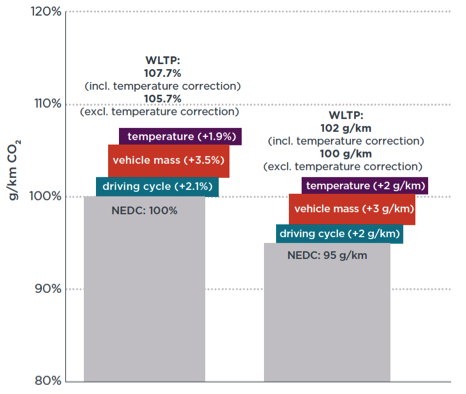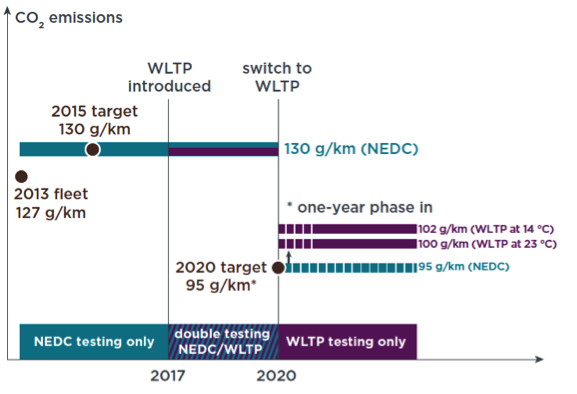The WLTP: How a new test procedure for cars will affect fuel consumption values in the EU
Blog
Will a new test procedure solve the problem? Latest developments on EU vehicle testing
Over the last few weeks, we published two major reports on the real-world emission behavior of passenger cars in Europe.
The first one talked about air pollutant emissions, specifically nitrogen oxide (NOx), from modern diesel cars. Here we analyzed detailed on-road driving data for fifteen Euro 6 equivalent diesel cars and found that the level of NOx emissions in everyday driving – on average – was about seven times as much as allowed by the Euro 6 regulation. Some cars had real-world emissions up to 25 times higher than allowed by the standard, which went into force in September 2014. Others had relatively low emissions, both in the laboratory and on the road, and thereby impressively demonstrated that up-to-date emission reduction technologies are capable of maintaining low emissions in the real world.
Our second report focused on carbon dioxide (CO2) emissions and fuel consumption. Aggregating real-world driving data for more than half a million cars in Europe, we found that new cars in 2013 – on average – had CO2 emissions that were more than 30 percent higher than the official manufacturers’ test results. The trend over time is particularly alarming: while in 2001 the discrepancy between official and real-world CO2 figures was only around 8 percent, it increased to about 17 percent in 2008 and then to more than 30 percent in 2013.
Together, these reports clearly demonstrate that there is a serious on-road problem for CO2 and NOx emissions in Europe. This is broadly recognized, and the European Commission is working on these issues. However, the two approaches chosen to address the real-world CO2 and the real-world NOx problem are substantially different.
For NOx, the European Commission is planning to implement the so-called Real Driving Emissions (RDE) procedure. In practice, what that means is that in the not-so-distant future new cars will have to be tested not only in the laboratory but also on the road, using ‘Portable Emissions Measurement Systems’ (PEMS). This should ensure that vehicles meet their NOx emission limits during normal driving and not only under narrowly defined test conditions. If EU Member States agree, then this new regulation will take effect from 2017 on. Details regarding the testing condition of these PEMS road tests are still being debated. Generally speaking, vehicle manufacturers want the testing conditions as narrowly specified as possible (for example, a defined maximum driving speed, road gradient, and altitude), whereas to obtain most realistic test results, the test conditions have to be kept as broad as possible. Another critical issue is the allowable ‘Conformity Factor’ (CF), i.e. the ratio that determines how much higher than the laboratory-based emission limit the PEMS road test results are allowed to be for a vehicle to pass the test. For example, a CF of 2.0 would mean that the on-road NOx limit is two times the laboratory limit, i.e., in the case of the Euro 6 standard 0.16 grams per kilometer (g/km) instead of 0.08 g/km. It is no surprise that different stakeholders have different opinions on what the value of the CF ought to be. Nevertheless, a political compromise for RDE is expected for the end of 2014. With the introduction of RDE in Europe there is reasonable hope that the real-world diesel NOx problem will be alleviated in a few years time.
For CO2, much hope lies on the introduction of the WLTP – a new test procedure that was developed at the United Nations level in recent years and is now ready for implementation at the regional and country level. As we show in a just released working paper, the WLTP will bring a number of much-needed improvements over the current European test procedure, the NEDC. It is therefore expected that WLTP CO2 and fuel consumption figures will be more realistic than is currently the case.
Many of the changes correct for ill-advised “flexibilities” in the NEDC, which might more accurately be called “loopholes”. Of course it is important to close these loopholes in the new test procedure, but at the same time any manufacturer that has exploited the existing loopholes should not be rewarded for doing so. This is important when translating the EU 2020/21 CO2 target of 95 g/km from NEDC to WLTP. Based on the in-depth assessment in our new working paper, there are three – and only three – key elements that should be taken into account when defining a NEDC-WLTP conversion factor: (1) The longer duration and larger speed variations on the new driving cycle, (2) the higher vehicle test mass, and (3) the lower engine temperature at test start. Together, these three elements add up to a conversion factor of 6–8%
Thus, in order to keep the level of ambition of the official CO2 targets, the already adopted 95 g/km NEDC target should be translated to 100 g/km (if test temperature is not adjusted) or 102 g/km (if test temperature is adjusted) in the WLTP (see Figure 1).

Fig. 1. Graphical illustration of the estimated impact from switching from NEDC to WLTP
In terms of timeline, the implementation of the WLTP in Europe is envisioned for 2017. It is likely that the WLTP will be applied first for purposes of informing consumers only (i.e., to determine the fuel consumption values in the sales brochures). Then from 2020/21 on, it will also be used to determine the CO2 figures that are subject to the EU’s CO2 standards (see Fig. 2). The final timeline is still subject to ongoing political discussions. According to news articles, parts of the car industry are trying to delay the introduction of WLTP beyond 2021.

Fig. 2. Schematic illustration of a possible timeline for the implementation of the WLTP in the EU
Unlike for NOx, vehicle CO2 emissions and fuel consumption will be subject to laboratory testing only – even after introduction of the WLTP. Testing CO2 emissions on the road is currently not part of the discussions in the EU. Similarly, a fundamental flaw in the European vehicle testing system is left untouched for now: while new vehicle models are subject to testing at type-approval, “in-use” testing is not foreseen at all. This means that – in the worst case – a carefully prepared “golden” test vehicle can be tested by a manufacturer to ensure that CO2 emission limits are met, as these test results will never be challenged by testing series production vehicles that are sold to customers. This is fundamentally different to the situation in the US, where the Environmental Protection Agency (EPA) regularly re-tests randomly selected vehicles on the road (see here for a summary of the US EPA vehicle compliance testing program). Recently this led to startling announcements by manufacturers like BMW and Daimler, who were forced to correct fuel consumption figures for some of their US cars. In the history of the European Union, such a regulatory move is unprecedented and even unthinkable. But it is an essential next step to ensure accurate CO2 measurements.
